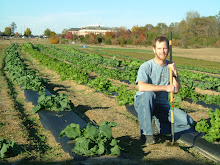I've been helping out with soil morphology labs this semester. We spent the last couple of weeks on a soil mapping exercise.
 First you start with a map of the area of interest, and locate boring holes.
First you start with a map of the area of interest, and locate boring holes.
 Once you reach the boring location, you use an auger to bore down to the depth of interest.
Once you reach the boring location, you use an auger to bore down to the depth of interest. Each auger-full of soil is laid out neatly with stick to mark the depth of the auger bucket. Here, the top of the soil is marked with the leaf, and bottom depth is in the upper left.
Each auger-full of soil is laid out neatly with stick to mark the depth of the auger bucket. Here, the top of the soil is marked with the leaf, and bottom depth is in the upper left.Some of the soil horizons are clearly visible in this photo.
 Each horizon is textured (for the amounts of sand, silt and clay), colored, and noted for other characteristics of interest.
Each horizon is textured (for the amounts of sand, silt and clay), colored, and noted for other characteristics of interest.This information will be placed into a GIS application, and a soil map will be made. Maps are then used to determine hydrology, yield potential for various crops, engineering properties, and many other applications.

7 comments:
This looks great. I bet its nice to get outdoors and take a break from the labs and prelims. I hope its all going well for you.
That looks like v. interesting work. Great to see that the data is transferred to soil maps etc.
Nice illustrative photos, especially of the bores laid out on the ground.
very interesting....nevere heard of soil mapping.
This is one blog I am sure learn something on when I visit! Very interesting!
I presume by "boring" you mean "interesting".
Morphology. You should call your dog "Morph". Ask Emma. http://bit.ly/DXnpD
Post a Comment